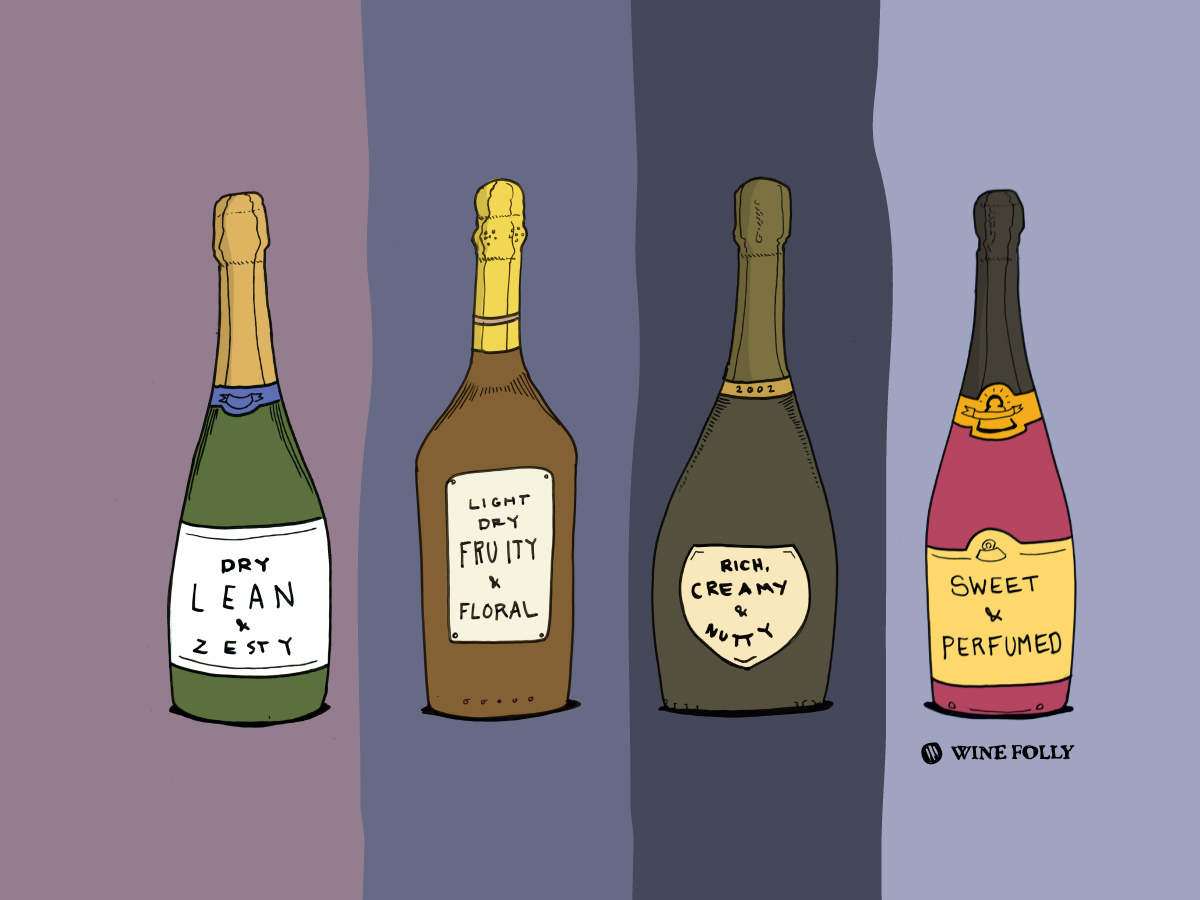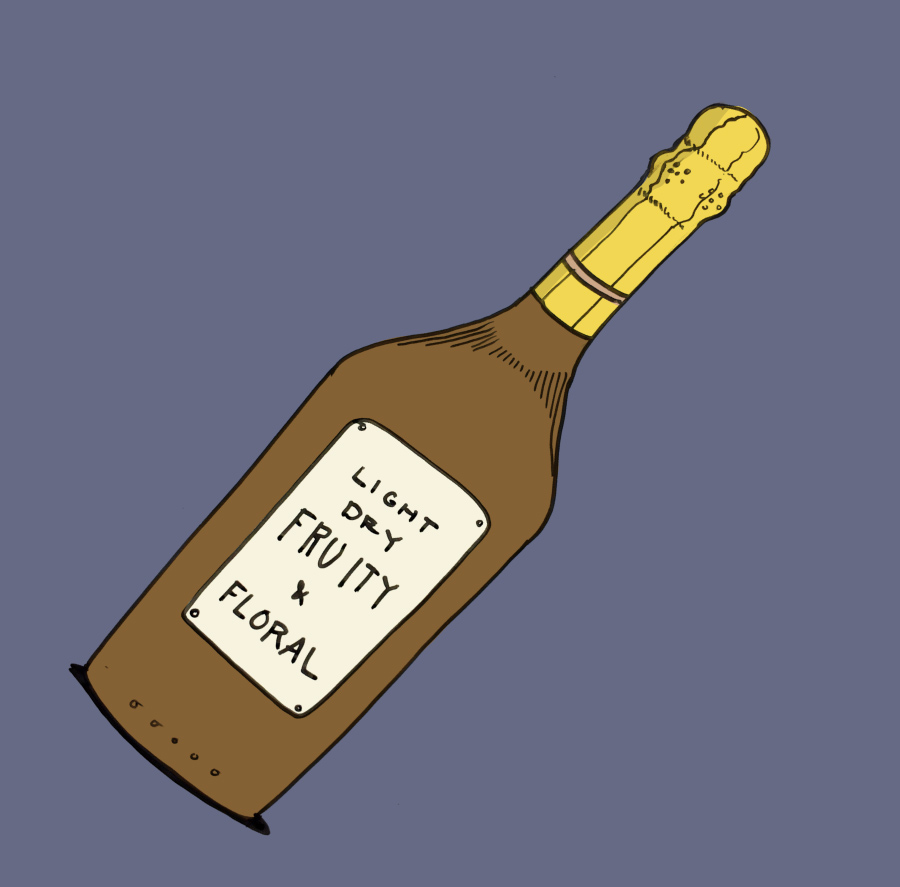Sparkling wine isn’t just Champagne, and if it were, even Champagne has quite a bit of diversity in style. So, in order to find your favorite type of bubbly let’s break down the different styles of sparkling wine based on taste including suggestions on wines that fit each profile.
Different Styles of Sparkling Wine
The most technically advanced style of wine in the world
Sparkling wine is (arguably) the most technical wine in the world. What makes the stuff so technical is that it undergoes not just one fermentation (to make the alcohol) but a second fermentation to make bubbles! Throughout the entire winemaking process, the winemaker has a lot of choices to make that will greatly affect the way the final wine tastes. And this is how we’ve come to discover sparkling wine’s many styles.
The Secret to Finding Your Style
Even within the small region of Champagne, you can find examples of wines that fit into each of the 4 categories. So how then, does one find the style they prefer? I’d like to let you in on a little secret into the world of bubbly wines. If you understand the winemaking based on the 2 primary techniques you can find your dream bubbly.
Zesty REDUCTIVE sparkling wines
Sparkling wine made with this style come out tasting lean with flavors of flowers, fresh apple, tropical fruit, lime and lemon zest. Wines tend to be light and zippy in the palate. The technique is called reductive winemaking and the ideology behind this method is to preserve as much of the floral and fruit character of the wine as possible. This means less oxygen is introduced during the winemaking process–this is where the term reductive comes from.
Styles produced with this method:
- Dry, Lean & Zesty
- Light, Dry, Fruity & Floral
- Sweet & Perfumed
Dry, Lean & Zesty
Dry and zesty wines are made with non-aromatic grapes like Chardonnay and Pinot Noir. They also typically come from the coolest climate wine regions.
To be dry, they have the least amount of sweetness added during dosage and are typically labeled as Brut (see all sparkling wine sweetness levels). Here are some wines that fall into this category:
- Most NV (non-vintage) Champagne
- Most Cava
- Most Brut and Extra Brut level sparkling wine
- Most Brut Nature (aka. Pas Dosé, Pas Dosage) sparkling wines
Light, Dry, Fruity, & Floral
Still light in taste, these wines have more floral and fruit notes typically from the grapes that have been blended into the wine. For example, the region of Franciacorta in Italy blends Pinot Grigio into their wine resulting in a fruitier (like white peaches!) flavor. You’ll also tend to find this style made in warmer climate growing regions, such as Sonoma, California. Here are some examples:
- Most Brut and Extra-Dry Prosecco (aka Valdobbiadene)
- Most Franciacorta (“fran-cha-court-ah”)
- Sparkling Rosé
- Riesling Sekt (from Germany and Austria)
- Most American, Argentine and South African (Cap Classique) sparkling wines
- Extra-Dry sparkling wines
Sweet & Perfumed
Sweet sparkling wines are either sweetened during the dosage portion of winemaking or are made with aromatic grapes like Muscat (aka Moscato). If the wine is sweetened by the dosage, it will be labeled with one of the several terms for sweet:
- Dry Prosecco (aka Valdobbiadene)
- Demi-Sec and Doux sparkling wines
- Amabile and Dolce Italian sparkling wines
- Brachetto d’Acqui (a Rosé wine)
- Asti Spumante (made with Moscato)
Creamy AUTOLYTIC and OXIDATIVE sparkling wines
Sparkling wines made with this style come out tasting rich and creamy with flavors of toast, brioche, yellow apple, honeycomb and sometimes hazelnut. This style is made with a technique often referred to as autolytic or oxidative winemaking. The ideology behind this particular method is to enhance the wine with the qualities of aging.
Styles produced with this method:
- Rich, Creamy & Nutty
Rich, Creamy, & Nutty
As you’ve probably guessed, autolytic sparkling wines are a more expensive process in terms of time and resources, which is why they tend to cost more (although great values can be found!). Seek out wines with an “extended tirage” which means they’ve rested on their lees a long time. This helps add to the creaminess. Then, look into the wine’s production. Many of the nuttiest sparkling wines are fermented in oak barrels.
- Reserva and Gran Reserva Cava
- Vintage Champagne, American Bubbles, Italian “Metodo Classico,” Franciacorta and Cap Classique with 3+ years on the lees.
How Oxygen and Autolysis Make Richer, Creamier Sparkling Wines
Oxygen: During the winemaking process the wines are often fermented in oak barrels which adds subtle oak flavoring but more importantly, the oak allows more oxygen into the winemaking. This is where the term “oxidative” comes from and it adds subtle nuttiness to the wine.
Autolysis: The autolytic side of this process happens while the wines sit in bottle after their second fermentation. The yeast responsible for the second fermentation die and dissolve (autolysis) and sit in the bottle. The longer the wines touch these yeast particles, called “lees”, the more creamy the wines become. Some sparkling wines, such as Krug Champagne or Cava Gramona (a Gran Reserva Cava) will age 6-7 years on the lees to develop a rich creamy and nutty texture.
Last Word
Next time you’re in a wine shop, tell the wine retailer the style you’re looking for based on the styles above and you’ll be able to get what you want.





